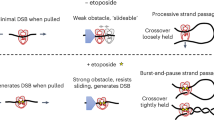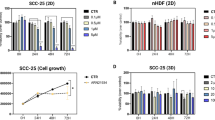Abstract
Topoisomerase II has been identified as the primary cellular target for a number of antitumor drugs currently being used in cancer chemotherapy. Topoisomerase I has also been found to be the target of camptothecin, an antitumor drug currently under development. Topoisomerases normally solve the topological problems of DN A, which are generated during replication, transcription and recombination, by breaking and rejoining the DNA strands. Topoisomerase-active antitumor drugs interfere with the breakage and rejoining reaction of topoisomerases by trapping an abortive enzyme-DNA “cleavable complex”. The formation of drug-induced “cleavable complexes” effectively converts the enzyme into a cellular poison. The high cellular level of topoisomerase II in some tumors may partly explain the high therapeutic index of these antitumor drugs. Studies of this type of DNA lesion are likely to provide important new information concerning the mechanism of cell killing by antitumor drugs.
This is a preview of subscription content, access via your institution
Access options
Subscribe to this journal
Receive 12 print issues and online access
$209.00 per year
only $17.42 per issue
Buy this article
- Purchase on Springer Link
- Instant access to full article PDF
Prices may be subject to local taxes which are calculated during checkout
Similar content being viewed by others
References
Wang, J.C. 1985. DNA Topoisomerases. Ann. Rev. Biochem. 54:665–697.
Wang, J.C. 1987. Recent studies of DNA topoisomerases. Biochim. Biophys. Acta. 909:1–9.
Liu, L.F. 1983. DNA topoisomerases—enzymes that catalyze the breaking and rejoining of DNA. CRC Critical Rev. of Biochem. 15:1–24.
Yang, L., Wold, M.S., Li, J.J., Kelly, T.J., and Liu, L.F. 1987. Roles of DNA topoisomerases in simian virus 40 DNA replication in vitro. Proc. Natl. Acad. Sci. U.S.A. 84:950–954.
Snapka, R.M. 1987. Topoisomerase inhibitors can selectively interfere with different stages of simian virus 40 DNA replication. N.C.I. Monogr. First conference on DNA topoisomerases in cancer chemotherapy. 4:55–60.
DiNardo, S., Voekel, K., and Sternglanz, R. 1984. DNA topoisomerase II mutant of Saccharomyces cerevisiae: Topoisomerase is required for separation of daughter molecules at the termination of DNA replication. Proc. Natl. Acad. Sci. U.S.A. 81:2616–2620.
Holm, C., Goto, T., Wang, J.C., and Botstein, D. 1985. DNA topoisomerase II is required at the time of mitosis in yeast. Cell 41:553–563.
Uemura, Y., and Yanagida, M. 1986. Mitotic spindle pulls but fails to separate chromosomes in type II DNA topoisomerase mutants:uncoordinated mitosis. EMBO J. 5:1003–1010.
Zhang, H., Wang, J.C., and Liu, L.F. 1988. Involvement of DNA topoisomerase I in transcription of human ribosomal RNA genes. Proc. Natl. Acad. Sci. U.S.A. 85:1060–1064.
Gilmour, D.S., and Elgin, S.C. 1987. Localization of specific topoisomerase I interactions within the transcribed regions of active heat shock genes by using the inhibitor camptothecin. Mol. Cell. Biol. 7:141–148.
Rowe, T.C., Couto, E., and Kroll, D.J. 1987. Camptothecin inhibits hsp 70 heat-shock transcription and induces DNA strand breaks in hsp 70 genes in Drosophila. N.C.I. Monogr. First Conference on DNA. Topoisomerases in Cancer Chemotherapy. 4:49–53.
Liu, L.F., and Wang, J.C. 1988. Supercoiling of the DNA template during transcription. Proc. Natl. Acad. Sci. U.S.A. 84:7024–7027.
Wu, H.-Y., Shyy, S., Wang, J.C., and Liu, L.F. 1988. Transcription generates positively and negatively supercoiled domains in the template. Cell 53:433–440.
Liu, L.F., Rowe, T.C., Yang, L., Tewey, K.M., and Chen, G.L. 1983. Cleavage of DNA by mammalian DNA topoisomerase II. J. Biol. Chem. 258:15365–15370.
Champoux, J.J. 1977. Strand breakage by the DNA untwisting enzyme results in covalent attachment of the enzyme to the DNA. Proc. Natl. Acad. Sci. U.S.A. 74:3800–3804.
Champoux, J.J. 1981. DNA is linked to the rat liver nicking-closing enzyme by a phosphodiester bond to tyrosine. J. Biol. Chem. 256:4805–4809.
Rowe, T.C., Chen, G.L., Hsiang, Y.-H., and Liu, L.F. 1986. DNA damage by antitumor acridines mediated by mammalian topoisomerase II. Cane. Res. 46:2021–2026.
Nelson, E.M., Tewey, K.M., and Liu, L.F. 1984. Mechanism of antitumor drug action:poisoning of mammalian DNA topoisomerase II on DNA by 4′-(9-acridinylamino)-methanesulfon-m-anisidide. Proc. Natl. Acad. Sci. U.S.A. 81:1361–1365.
Kessel, D., Bosmann, H.B., and Lohr, K. 1972. Camptothecin effects on DNA synthesis in murine leukemia cells. Biochim. Biophys. Acta 269:210–216.
Horwitz, M.S., and Horwitz, S.B. 1971. Intracellular degradation of HeLa and Adenovirus type 2 DNA induced by camptothecin. Biochem. Biophys. Res. Commun. 45:723–727.
Loike, J.D., and Horwitz, S.B. 1976. Effect of VP-16-213 on the intracellular degradation of DNA in HeLa cells. Biochem. 15:5443–5448.
Burr Furlong, N., Sato, J., Brown, T., Chavez, F., and Hurlbert, R.B. 1978. Induction of limited DNA damage by the antitumor agent Cain's acridine. Cancer Res. 38:1329–1335.
Robertson, I.G.C., Denny, W.A., and Baguley, B.C. 1980. Inhibition of T4 bacteriophage yield by 9-anilinoacridines; comparison with in vivo antitumor activity. Eur. J. Cancer 16:1133–1139.
Baguley, B.C., and Nash, R. 1981. Antitumor activity of substituted 9-anilinoacridines—comparison of in vivo and in vitro testing systems. Eur. J. Cancer 17:671–679.
Ross, W.E., Glaubinger, D.L., and Kohn, K.W. 1979. Qualitative and quantitative aspects of intercalator-induced DNA strand breaks. Biochim. Biophys. Acta 562:41–50.
Marshall, B., Ralph, R.K., and Hancock, R. 1983. Blocked 5′-termini in the fragments of chromosomal DNA produced in cells exposed to the antitumor drug 4′-(9-acridinylamino)methanesulfon-m-anisidide (m-AMSA). Nucl. Acids Res. 11:4251–4256.
Ralph, R.K., and Hancock, R. 1985. Chromosomal DNA fragment from mouse cells exposed to an intercalating agent containing a 175-kdalton terminal polypeptide. Can. J. Biochem. Cell. Biol. 63:780–783.
Zwelling, L.A., Michaels, S., Erickson, L.C., Ungerleider, R.S., Nichols, M., and Kohn, K.W. 1981. Protein-associated deoxyribonu-cleic acid strand breaks in L1210 cells treated with deoxyribonucleic acid intercalating agents 4′-(9-acridinylamino)methanesulfon-m-anisidide and adriamycin. Biochem. 20:6553–6563.
Ross, W.E., Glaubinger, D.L., and Kohn, K.W. 1978. Protein-associated DNA breaks in cells treated with adriamycin or ellipticine. Biochim. Biophys. Acta 519:23–30.
Filipski, J., and Kohn, K.W. 1982. Ellipticine-induced protein-associated DNA breaks in isolated L1210 nuclei. Biochim. Biophys. Acta 698:280–286.
Ross, W.E., Zwelling, L.A., and Kohn, L.W. 1979. Relationship between cytotoxicity and DNA strand breakage produced by adriamycin and other intercalating agents. Int. J. Radiat. Oncol. Biol. Phys. 5:1221–1225.
Tewey, K.M., Rowe, T.C., Yang, L., Halligan, B.D., and Liu, L.F. 1984. Adriamycin-induced DNA damage mediated by mammalian DNA topoisomerase II. Science 226:466–468.
Tewey, K.M., Chen, G.L., Nelson, E.M., and Liu, L.F. 1984. Intercalative antitumor drugs interfere with the breakage-reunion reaction of mammalian DNA topoisomerase II. J. Biol. Chem. 259:9182–9187.
Chen, G.L., Yang, L., Rowe, T.C., Halligan, B.D., Tewey, K.M., and Liu, L.F. 1984. Nonintercalative antitumor drugs interfere with the breakage-reunion reaction of mammalian DNA topoisomerase II. J. Biol. Chem. 259:13560–13566.
Ross, W.E., Rowe, T.C., Glisson, B., Yalowich, J., and Liu, L.F. 1984. Role of topoisomerase II in mediating epipodophyllotoxin induced DNA cleavage. Cancer Res. 44:5857–5860.
Yang, L., Rowe, T.C., Nelson, E.M., and Liu, L.F. 1985. In vivo mapping of DNA topoisomerase II specific cleavage sites on SV40 chromatin. Cell 41:127–132.
Yang, L., Rowe, T.C., and Liu, L.F. 1985. Identification of DNA topoisomerase II as an intracellular target of antitumor epipodophyl-lotoxins in SV40 infected monkey cells. Cancer Res. 45:5872–5876.
Rowe, T.C., Chen, G.L., Hsiang, Y.-H., and Liu, L.F. 1986. DNA damage by antitumor acridities mediated by mammalian DNA topoisomerase II. Cancer Res. 46:2021–2026.
Long, B.H. 1987. Structure-activity relationships of podophyllotoxin congeners that inhibit topoisomerase II. N.C.I. Monogr. First Conference on DNA Topoisomerases in Cancer Chemotherapy. 4:123–127.
Rowe, T.C., Kupfer, G., and Ross, W.E. 1985. Inhibition of epipodophyllotoxin cytotoxicity by interference with topoisomerase-mediated DNA cleavage. Biochem. Pharm. 34:2483–2487.
Glisson, B., Gupta, R., Smallwood-Kentro, S., and Ross, W. 1986. Characterization of acquired epipodophyllotoxin resistance in a Chinese hamster ovary cell line: loss of drug-stimulated DNA cleavage activity. Cancer Res. 46:1934–1938.
Glisson, B., Gupta, R., Hodges, P., and Ross, W. 1986. Cross-resistance to intercalating agents in an epipodophyllotoxin-resistant Chinese hamster ovary cell line: evidence for a common intracellular target. Cancer Res. 46:1939–1942.
Bodley, A.L., Liu, L.F., Israel, M., Giuliani, F.C., Silber, R., Kirs-chenbaum, S., and Potmesil, M. 1988. DNA Topoisomerase II mediated of doxorubicin and daunomycin congeners with DNA. Cancer Res. manuscript submitted.
Kupfer, G., Bodley, A.L., and Liu, L.F. 1987. Involvement of intracellular ATP in cytotoxicity of topoisomerase-targeting antitumor drugs. N.C.I. Monogr. First Conference on DNA Topoisomerases in Cancer Chemotherapy. 4:37–40.
Drlica, K. 1984. Biology of bacterial deoxyribonucleic acid topoisomerases. Microbiol. Rev. 48:273–289.
Pedrini, A.M. 1979. Nalidixic acid. Antibiotics (NY) 5:154–175.
Chen, G.L., and Liu, L.F. 1986. DNA topoisomerases as therapeutic targets in cancer chemotherapy. Ann. Reports Med. Chem. 21:257–262.
Bodley, A.L., and Liu, L.F. 1988. Roles of DNA topoisomerases in drug cytotoxicity and drug resistance. Bristol-Myers Cancer Symposia: Mechanisms of Drug Resistance in Neoplastic Cells 9:277–286.
Dillehay, L.E., Denstman, S.C., and Williams, J.R. 1987. Cell cycle dependence of sister chromotid exchange induction by DNA topoisomerase II inhibitors in Chinese hamster V79 cells. Cancer Res. 47:206–209.
Deaven, L.L., Oka, M.S., and Tobey, R.A. 1978. Cell-cycle-specific chromosome damage following treatment of cultured Chinese hamster cells with 4′-(9-acridinylamino)methanesulfon-m-anisidide-HCl. J. Natl. Cancer Inst. 60:1155–1161.
DeMarini, D.M., Doerr, C.L., Meyer, M.K., Brock, K.H., Hozier, J., and Moore, M.M. 1987. Mutagenicity of m-AMSA and o-AMSA in mammalian cells due to clastogenic mechanism:possible role of topoisomerase. Mutagenesis 2:349–355.
Scher, W., and Friend, C. 1978. Breakage of DNA and alterations in folded genomes by inducers of differentiation in murine erythroleukemia cells. Cancer Res. 38:841–849.
Walker, G.C. 1984. Mutagenesis and inducible responses to deoxyribonucleic acid damage in Eschericia coli. Microbiol. Rev. 48:60–93.
Walker, G.C., Marsh, L., and Dodson, L.A. 1985. Genetic analysis of DNA repair: inference and extrapolation. Ann. Rev. Genet. 19:103–126.
Nitiss, J., and Wang, J.C. 1988. Actions of DNA topoisomerase-targeting antitumor drugs can be studied in yeast mutants. Proc. Natl. Acad. Sci. U.S.A. in press.
Nelson, W.G., Cho, K.R., Hsiang, Y.-H., Liu, L.F., and Coffey, D.S. 1987. Growth related elevations of topoisomerase II levels found in Dunning R3327 rat prostatic adenocarcinomas. Cancer Res. 47:3246–3250.
Hsiang, Y.-H., Wu, H.-Y., and Liu, L.F. 1988. Proliferation-dependent regulation of DNA topoisomerase II in cultured human cells. Cancer Res. 48:3230–3235.
Baguley, B.C., and Cain, B.F. 1982. Comparison of the in vivo and in vitro antileukemic activity of monosubstituted derivatives of 4′-(9-acridinylamino)methanesulfon-m-anisidide. Molecular Pharm. 22:486–492.
Potmesil, M., Hsiang, Y.-H., Liu, L.F., Wu, H.-Y., Traganos, F., Bank, B., and Silber, R. 1987. DNA topoisomerae II as a potential factor in drug resistance of human malignancies. N.C.I. Monogr. First Conference on DNA Topoisomerases in Cancer Chemotherapy 4:105–109.
Spadari, S., Pedrali-Noy, G., Focher, F., Montecucco, A., Bordoni, T., Geroni, C., Giuliani, F.C., Ventrella, G., Arcamone, F., and Ciarroc-chi, G. 1986. DNA polymerases and DNA topoisomerases as targets for the development of anticancer drugs. Anticancer Res. 6:935–940.
Abelson, H.T., and Penman, S. 1972. Selective interruption of high molecular weight RNA synthesis in HeLa cells by camptothecin. Nature 237:144–146.
Hsiang, Y.-H., Hertzberg, R., Hecht, S., and Liu, L.F. 1985. Camptothecin induces protein-linked DNA breaks via mammalian DNA topoisomerase I. J. Biol. Chem. 260:14873–14878.
Mattern, M.R., Mong, S.-M., Bartus, H.F., Mirabelli, C.K., Crooke, S.T., and Johnson, R.K. 1987. Relationship between the intracellular effects of camptothecin and the inhibition of DNA topoisomerase I in cultured L1210 cells. Cancer Res. 47:7193–7198.
Andoh, T., Ishii, K., Suzuki, Y., Ikegami, Y., Kusunoki, Y., Takemoto, Y., and Okada, K. 1987. Characterization of a mammalian mutant with a camptothecin-resistant DNA topoisomerase I. Proc. Natl. Acad. Sci. U.S.A. 84:5565–5569.
Kjeldson, E., Bonven, B.J., Andoh, T., Ishii, K., Okada, K., Bolund, L., and Westergaard, O. 1988. Characterization of a camptothecin-resistant human DNA topoisomerase I. J. Biol. Chem. 263:3912–3916.
Author information
Authors and Affiliations
Rights and permissions
About this article
Cite this article
Bodley, A., Liu, L. Topoisomerases as Novel Targets for Cancer Chemotherapy. Nat Biotechnol 6, 1315–1319 (1988). https://doi.org/10.1038/nbt1188-1315
Issue Date:
DOI: https://doi.org/10.1038/nbt1188-1315
This article is cited by
-
Inhibition of topoisomerase II α activity and induction of apoptosis in mammalian cells by semi-synthetic andrographolide analogues
Investigational New Drugs (2013)



